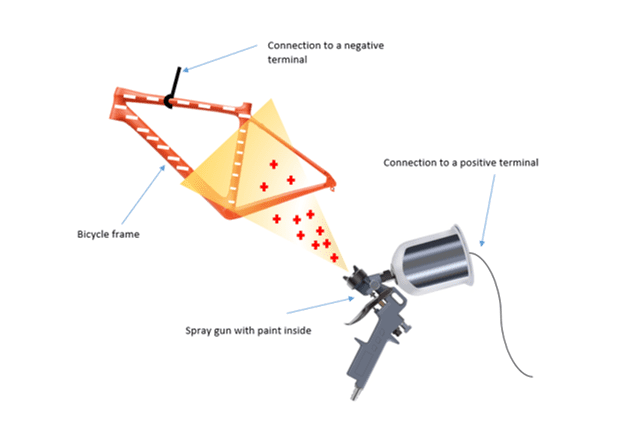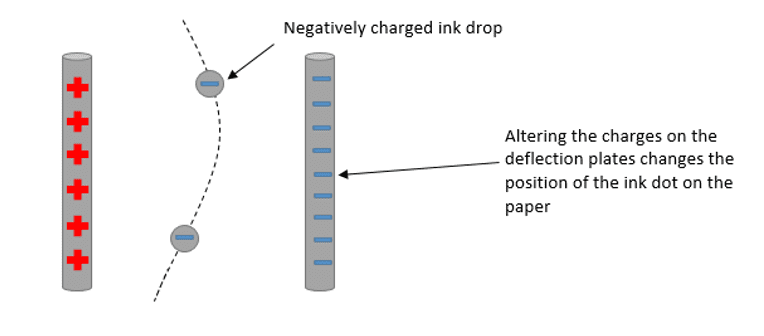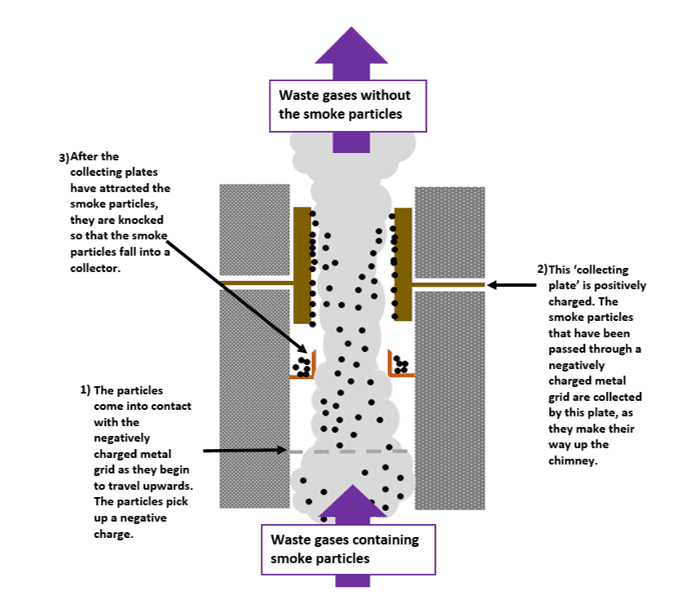In this post
Insulating materials do not conduct electricity and have no charge overall. However, they do have the potential to become charged using friction. If an uncharged cloth is rubbed against an uncharged plastic rod, electrons from the rod may transfer onto the cloth. The cloth has gained electrons and the rod has lost electrons which means that they have both become charged. The cloth has a negative electrostatic charge and the rod has a positive electrostatic charge, as shown in the diagram.

Charged objects can exert a force onto one another even though they may not be in contact. If both objects have like charges, i.e. they are both positively or both negatively charged, they will exert forces of repulsion against one another causing them to move away from each other. An example of this can be seen using a magnet. The south poles of a magnet are positively charged and the north poles are negatively charged. If two south poles are placed next to each other, they will push each other away and cannot be forced together. Similarly, if two north poles are placed next to each other, they will repel one another and will not touch.
If the two objects have unlike charges, i.e. one is positively charged and the other is negatively charged, there will be a force of attraction and the two objects will move towards each other until they are touching. This again can be seen using the example of two magnets. If the north pole of one magnet and the south pole of the other magnet are placed next to one another, they will move towards each other and will touch.
There are forces of attraction between unlike charges and forces of repulsion between like charges.
An object that is charged can also attract an object that is uncharged. This can be demonstrated using an inflated balloon. By rubbing the inflated balloon against your hair or clothes, you can induce a charge. The electrons will move from your hair or clothes leaving them positively charged. The balloon gains the electrons and becomes negatively charged. The negatively charged balloon can then be placed against an uncharged object such as a wall and it will stick to it, as shown in the diagram.

As the diagram shows, the positive charges in the wall are attracted towards the negative charges on the surface of the wall and the negative charges are repelled away. The force of attraction between the positively charged wall surface and the negatively charged surface of the balloon causes the balloon to stick to the wall.
Uses of static electricity
When two uncharged objects come into contact the force of friction between them may cause electrons to swap from one to the other, leading to an imbalance in electrons and the gaining of electrostatic charges, as previously discussed. This electrostatic charge on the surface of a material is commonly known as static electricity. Static electricity can be used to help us with a variety of activities such as photocopying, printing using inkjet printers and paint spraying.
Electrostatic paint spraying
If you were to paint an object such as a bicycle frame or a car, you could use electrostatic spraying to make the process more efficient. Electrostatic paint spraying allows the paintwork to be more evenly applied and therefore prevents lumps on the paint or areas being left unpainted. A spray gun is used to apply the paint in droplet form.

As you can see in the diagram, the bike frame has a wire attached to it and this is connected to a device which supplies a negative charge. A stream of electrons passes through the frame leaving it negatively charged. Similarly, the paint gun is connected by a wire to a positive terminal. This causes all of the paint droplets emerging from the spray gun to also become positively charged. The positively charged paint droplets are attracted towards the negatively charged bicycle frame resulting in an even coat of paint, especially in places a paintbrush would not reach such as the corners of the frame.
Inkjet printing
Modern day printers are inkjet, and this includes a fine jet of ink falling onto paper. Each spot of ink is given a charge that falls between two plates known as deflecting plates. Electrostatic forces in the printer direct the ink to the correct place. The charges change hundreds of times each second resulting in a fast stream of ink that forms pictures and words.

Photocopiers
When a photocopier is being used, the image of the document to be copied is projected onto a copying plate which is positively charged. Inside the machine there is a source of light. When the light hits the image on the positive plate, the charge is removed from those areas where no image has been copied (i.e. the white parts of the image). The parts of the plate where the image has been copied remains positively charged. The toner ink used is negatively charged and is attracted towards the areas of positive charge. Paper is then placed over the copying plate and the areas of black ink are transferred onto the paper, producing a copy of the original image.
Electrostatic precipitators
When fossil fuels such as coal and oil are burned, smoke is produced. This could cause pollution as the particles are solid and usually consist of dense materials such as carbon. To avoid this, the smoke can be removed from waste gases before they pass the chimney and escape into the atmosphere. The device that is used to do this is called an electrostatic precipitator. The diagram below explains how these work.

Also, electrostatic charges can be very useful; there are also times when they aren’t helpful. For example, TV screens and monitors also become charged. These charges attract uncharged particles such as dust. Clothing can also become charged with static electricity, giving us a shock when we remove them as the charges attempt to escape to the ground.
The potential dangers of electrostatic electricity
Electrostatic charges can also pose great danger in certain situations due to their unwanted effects on the way that objects interact. For example, when refuelling aircraft or tankers, the presence of electrostatic charges may cause an explosion. When aircraft are flying, they may become electrostatically charged. When they land, this build-up of electrostatic charge may well still be present on the body of the aircraft. During the process of refuelling, electrostatic charges can also build up.
The presence of these electrostatic charges can cause sparks which could ignite the fuel and cause an explosion. To prevent this from happening, the aircraft is earthed prior to fuelling using an earthing cable. This means that any excess electrostatic charges present can be carried down the earthing wire away from the aircraft body.
When tankers are being refuelled, a build-up of electrostatic charge may occur due to the fuel passing along the fuel hose. Tankers are also earthed prior to refuelling to prevent this causing any sparks or explosions.



